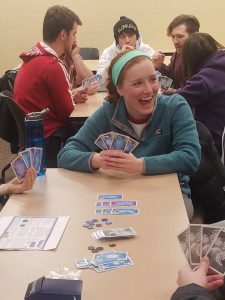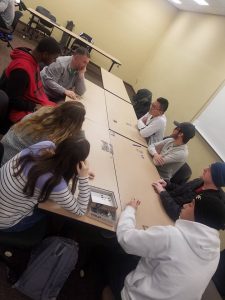“Wait, so the first 70 minutes of class they just play games? Do you even teach?”
Yep- students have the first 70 minutes of our weekly meeting to play through the various games of that particular week. Why do JS and I show up? Besides to join in the fun? Well, “you” asked, so let’s do this…
I’ve gone back and forth on best ways to write this, and I think the easiest is to give a sample of how we could have written the course in a way that reflected each of the following styles followed by an explanation as to why we chose the style we did. There is a ton of research available on different teaching styles, but I will only focus on a few here to keep you from having to read a dissertation-length entry!
Lecture Based/Authoritative Classroom
Many times in higher education, we are stuck on lecture and note based courses. We, as the teacher of the course, have all the information, and they only way students can have that information is if we talk at you. Is there a time and place for this type of learning? Certainly. Some learn best this way, some teach best this way.
Example: Having students copy copious amounts of notes on the history of boardgames from powerpoint slides and telling stories about why we, as the instructors, believe leadership is found in certain games.
Why Not Chosen: JS and I both learn very differently than what is offered through this style. We also believe that we can teach the course topic more effectively through another means. We do use some direct instruction when we briefly review a reading we offer to students, but this always takes less than 10 minutes of the class.
Flipped Classroom
I have seen this style of classroom learning become more and more popular in the last few years with peers and other instructors. This style occurs when the learning is placed completely in the students hands to decide what they want to learn about and how deeply. The instructor here is more of a guide person to help find answers as needed.
Example: Letting students decide what leadership topics they want to learn about and choose what games they would like to try to make it happen.
Why Not Chosen: Well, as much as we would like to let students develop with means they choose, the reality is that we were awarded so much money and bought a limited amount of games. Also, most schools require your courses have an intended outcome, so…. Although, we do use aspects of this method in our debriefs of the games by having pre-determined questions we want to touch on, but allow students to develop other points of discussion as it progresses.
Co-constructed Classroom
This style of classroom is somewhat of a hybrid of the flipped classroom. It recognizes that students have great information to share with the class, and so do the instructors. It allows instructors to create a general map of learning outcomes, while giving students options to choose how they will arrive at those locations. This style encourages both students and instructors to bring their past knowledge to the table and build off of one another to create something new, together.
Example: Dedicating a class that students can pick from 5-6 different games to play and discuss a specific leadership topic and how it relates to something they’ve experienced in their own life. Additionally, allowing students to restructure or modify the games to see if it changes how they see leadership play out in the game.
Why Chosen: If you look way back in our posts, you’ll find a little diddy about Bloom’s Taxonomy and how creation is at the top. This style can be really scary both for the instructors and the students because there is a lot of unknown involved. However, this can also be the most empowering, because in the end, everyone is discovering and creating something new, together.
So do JS and I do nothing while the students are playing the first part of class? NO!! Our job is to still be present and teach. We are also learning and actively participating. Yay for multitasking!

Student playing Hanabi.
- We make sure games are running smoothly and serve as a rule touchpoint. Students are asked to come prepared knowing the games, however, we all know there are some super wickedly confusing rules in games. We also make sure the groups are largely following the rules at the beginning. Sometimes we miss things. Usually it is no problem, but sometimes it changes the outcome of the game- and even might ruin the learning outcome we want you to reach.

Group of students playing The Resistance: Avalon
2. We are constantly observing. We are making sure everyone is playing and learning who skimmed the rules the night before. We are making mental notes as to which groups are playing the game for different outcomes. We are seeing who to press deeper in the group debrief about their experience. These observations help to guide our debrief section to be an even deeper and greater learning experience for all involved. (AND, this part helps us learn what to modify in the future renditions of the class, too!)

Group of students playing Secret Hitler
3. Most importantly, we are interacting with the students in the moment. Laugh with them. Learn with them when the game goes a-wire. Help set the mood at the beginning of a round. Add storyline into the game to give context. This is a part of the co-creation (outside of the debriefs). “Oh, you were killed the past 3 times this game? Why? Teammates, why do you not trust this character? Have you tried _____?” “You’ve used all of your fireworks. Must be a bright sky! Congratulations!”
The fact of matter is this: just because instructors are not standing at the front of the classroom and pouring information into the students does not mean the students are not learning and the instructors are not teaching. Learning and teaching can happen in many different ways. What is important, is to find the ways that work best for you- and do it!

